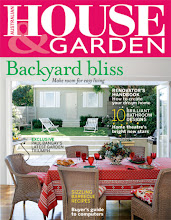
 de Gournay's - Chinoiserie Chelsea on custom yellow background wallpaper; email at info@degournay.com
de Gournay's - Chinoiserie Chelsea on custom yellow background wallpaper; email at info@degournay.com Verandah Home & Garden Living Solutions - Tablescape; Wall painted in Jervis Bay Blue, British Paints; Tall conical blue & white vase from Shanghai; Blue & white bowl with lid from Kelantung Malaysia; Bohemia Crystal Rib Vase with Cymbidium orchid; Oblong Frosted Lamp, Ikea.
Verandah Home & Garden Living Solutions - Tablescape; Wall painted in Jervis Bay Blue, British Paints; Tall conical blue & white vase from Shanghai; Blue & white bowl with lid from Kelantung Malaysia; Bohemia Crystal Rib Vase with Cymbidium orchid; Oblong Frosted Lamp, Ikea.Chinoiserie -
1.a style of ornamentation current chiefly in the 18th century in Europe, characterized by intricate patterns and an extensive use of motifs identified as Chinese.
2.an object decorated in this style or an example of this style: The clock was an interesting chinoiserie.
[Origin: 1880–85; <>Chinese + -erie -ery]
1.a style of ornamentation current chiefly in the 18th century in Europe, characterized by intricate patterns and an extensive use of motifs identified as Chinese.
2.an object decorated in this style or an example of this style: The clock was an interesting chinoiserie.
[Origin: 1880–85; <>Chinese + -erie -ery]









 decorator item to make your 'holiday' look just right. There's nothing like it! Having visiting stores in the States I fell in love their ability to merchandise everything from a tea light candle to a 9ft dining table with matching 4 stack plate setting and cutlery!
decorator item to make your 'holiday' look just right. There's nothing like it! Having visiting stores in the States I fell in love their ability to merchandise everything from a tea light candle to a 9ft dining table with matching 4 stack plate setting and cutlery!







